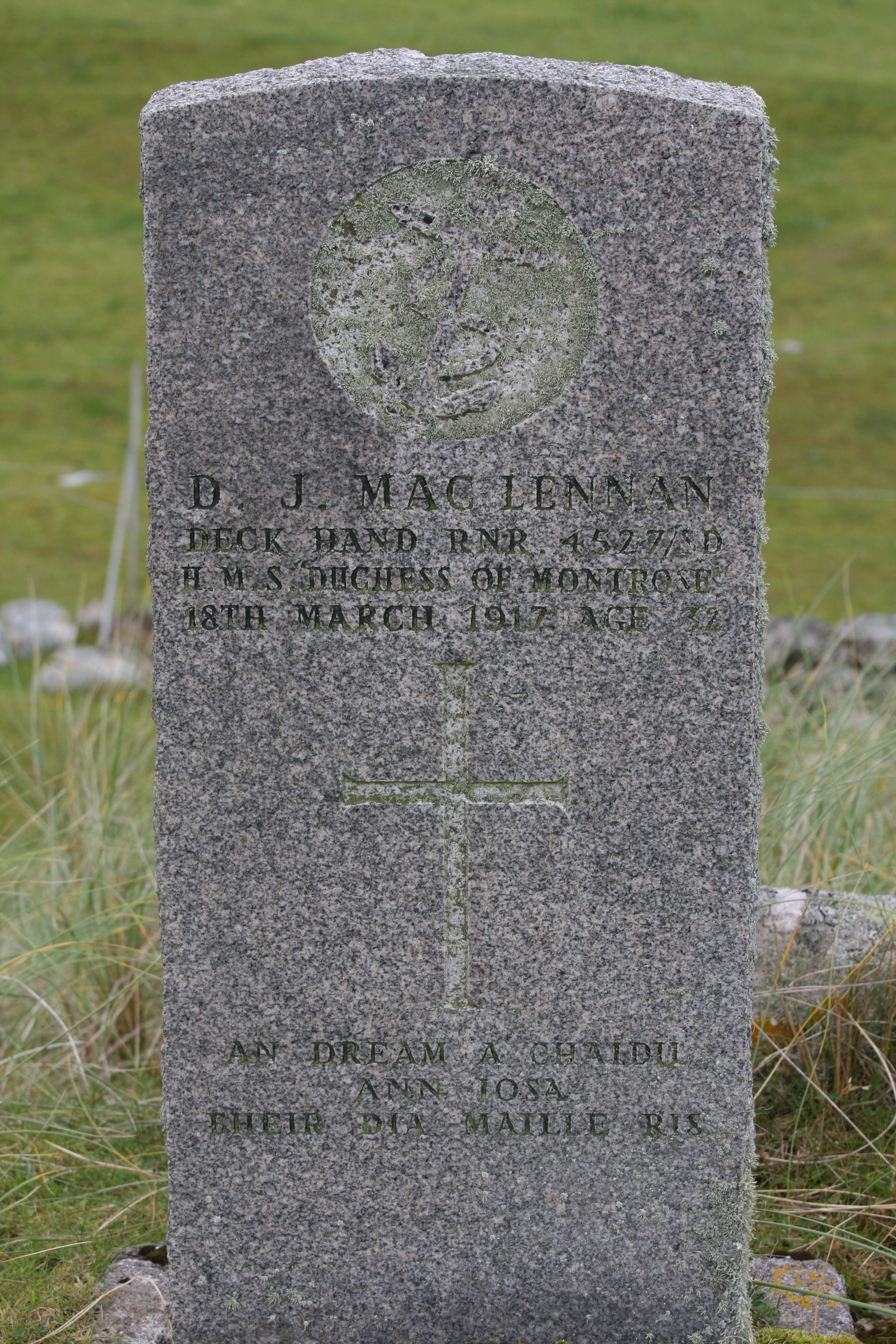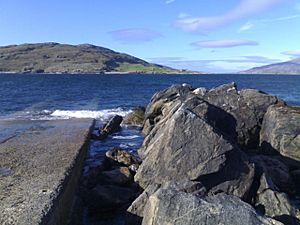Scarp, Scotland facts for kids
| Gaelic name | An Sgarp |
|---|---|
| Meaning of name | "Barren", from Norse |
 North coast of Scarp with view to the west |
|
| OS grid reference | NA970151 |
| Coordinates | 58°02′N 7°07′W / 58.03°N 7.12°W |
| Physical geography | |
| Island group | Harris and Lewis |
| Area | 1,045 ha (4 sq mi) |
| Area rank | 48 |
| Highest elevation | Sròn Romul 308 m (1,010 ft) |
| Administration | |
| Sovereign state | United Kingdom |
| Country | Scotland |
| Council area | Western Isles |
| Demographics | |
| Population | 0 |
Scarp (pronounced 'Skarp') is a small island in Scotland. It's part of the Outer Hebrides, a group of islands off the west coast. Scarp is located west of a place called Hushinish on the larger island of Harris.
Even though no one lives there now, Scarp used to be home to many people. It's famous for some interesting, but unsuccessful, experiments with 'rocket mail' – trying to send letters by rocket! These events have even been made into films.
Contents
Island Life on Scarp
Scarp is about 10.45 square kilometers (4 square miles) in size. It was once divided into 16 'crofts', which are small farms. Most of the island is rocky and not suitable for farming. It has two main hills, with the tallest reaching 308 meters (1,010 feet) high.
There is a small area of good land in the southeast. This is where the islanders used to live, closest to Harris. In 1881, Scarp's population reached its highest at 213 people. Even in the 1940s, over 100 people lived there.
The island was settled by eight farming families in 1810. More people moved there after they were moved from their homes on Harris. However, the island could not support so many people. There wasn't enough good land for farming, and there was no safe harbor for boats in bad weather. Because of this, many families eventually left.
Even in the 1950s, life was simple. People grew potatoes, cabbages, oats, and turnips. They also relied on milk, fish, and lobster fishing.
The Island Parliament
Scarp was like some other Scottish islands, such as St Kilda. All the men on the island would gather every morning in a special meeting. They called this meeting a "parliament." Here, they would decide what work needed to be done that day. Sometimes these meetings lasted for many hours. On those days, only the women on the island would do any work.
Farming and Fishing
Life on Scarp was mainly about crofting. This meant raising sheep and dairy cattle. Fishing was also very important. In later years, lobster fishing became a main way for about 12 families to earn money.
The islanders were also very religious. A Church of Scotland Mission House was a central place for Sunday worship and weekly prayer meetings.
Leaving the Island
The number of people living on Scarp kept going down in the 1950s and 1960s. The island's primary school closed in 1967. The post office closed in 1968. These closures were big reasons why people left. By 1971, only 12 people lived on Scarp. By the end of that year, the last permanent residents had moved to Harris.
However, a few houses on Scarp are still used today. They are holiday homes for people who visit the island sometimes.
Getting to Scarp
You can reach Scarp by a short boat trip. The boat crosses the Kyle of Scarp from Hushinish. But the sea here is very shallow. Landing on Scarp can be tricky when the waves are big.
The Rocket Mail Experiment
Scarp was the place for a very unusual experiment. A German inventor named Gerhard Zucker tried to deliver mail using rockets! This was called "rocket mail."
In July 1934, Zucker tried twice to send rocket mail between Scarp and Harris. Both attempts were not successful. You can still see some of the burnt envelopes from the exploded rocket at the island museum.
Scarp in Films and Art
The Rocket Post Film
The story of the rocket mail experiment was used in a film called The Rocket Post. This movie came out in 2006. It was filmed on Harris and Taransay, not on Scarp itself. The director was Stephen Whittaker. The filmmakers originally wanted to film on Scarp. But the island's owner did not allow it, so they moved to Taransay.
Art on the Island
The artist Norman Adams bought a croft house on Scarp in 1963. He lived there with his wife Anna and their two sons. Over the next ten summers, he painted many of his famous works on the island. He used his own special style.
A Story from a Book
There are many mentions of the grave of  in the book Not Forgotten (2006). This book was written by Neil Oliver. Donald John is buried at Scarp Burial Ground. He died on March 18, 1917. His ship, the PS Duchess of Montrose, hit a mine near Dunkirk during the First World War.
in the book Not Forgotten (2006). This book was written by Neil Oliver. Donald John is buried at Scarp Burial Ground. He died on March 18, 1917. His ship, the PS Duchess of Montrose, hit a mine near Dunkirk during the First World War.
Who Owns Scarp?
Scarp has been bought and sold several times over the years. In 1978, a company from Panama bought it for £100. It was then sold again in 1983 for £50,000. Soon after, it was sold for £500,000. These deals involved a bank that later had problems. In 1995, the island was sold again for £155,000 to Mr. Anderson Duke Bakewell, who owns it today.


